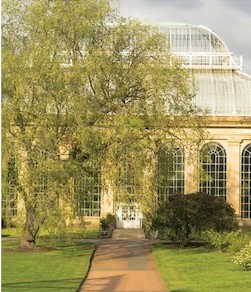Historical Movers and Shakers in Garden Design
Plot Pioneers
Historical Movers and Shakers in Garden Design
WRITTEN BY CATRIONA TUDOR ERLER
In the fashion industry, styles come and go. Today’s hot look is passé tomorrow and the day after is transformed into retro chic. The same style rules apply to gardens. Throughout the centuries, the trendsetters of the day are supplanted by the next generation of designers who have groundbreaking new ideas. Some of the ideas are perennial, while others die back at the end of the season. Each era has informed the one before, and together the work of the field’s movers and shakers represent a Western gardening heritage that continues to influence landscape design.
FORMALITY EXPRESSED
For the Everyman of the early centuries, gardens were not intended for pleasure; they were practical plots to grow food and medicinal herbs for the family. The plots were enclosed to keep out foraging beasts such as sheep, cattle, and deer, and fruit trees were often espaliered along the walls or fences to provide fruit in the smallest space possible.
The wealthy created gardens like those described by the first-century Roman Pliny the Younger. He described terraces cut into slopes, methodically trimmed shrubs, and basins and fountains (including hidden fountains designed to surprise spectators with an unexpected spray). These gardens were formal and symmetrical, with a central axis and a number of cross axes forming a grid pattern.
THE ENGLISH LANDSCAPE MOVEMENT
 George Washington and Thomas Jefferson gardened when styles were in transition from the rigid formality of the earlier centuries to a more naturalistic design. Both adopted the new look for their gardens, although Washington kept an elaborate parterre clipped and shaped into a fleur-de-lis. When architect Benjamin Latrobe stayed at Mount Vernon in July 1796, he described the parterre in a letter, concluding that it represented, “. . . the expiring groans I hope of our grandfather’s pedantry.”
George Washington and Thomas Jefferson gardened when styles were in transition from the rigid formality of the earlier centuries to a more naturalistic design. Both adopted the new look for their gardens, although Washington kept an elaborate parterre clipped and shaped into a fleur-de-lis. When architect Benjamin Latrobe stayed at Mount Vernon in July 1796, he described the parterre in a letter, concluding that it represented, “. . . the expiring groans I hope of our grandfather’s pedantry.”
The new look, pioneered in England by men such as William Kent (1685–1748), who is known as the father of modern gardening. His protégée, Lancelot “Capability” Brown (1716–1783), earned his nickname because whenever he saw a garden with problems, he always said, “It has great capabilities.” Finally, Humphry Repton (1752–1818) was the first to coin the term landscape gardener. With his red books, he also pioneered the concept of before-and-after drawings as a marketing tool for his clients.
The naturalistic landscapes created by these men were designed to replicate nature, but in perfection. They would dig lakes, remove or build hills, and in some cases, move an entire village to improve the outlook. Follies such as temples and grottos were all the rage.
VICTORIAN EMBELLISHMENT
By the nineteenth century, people had enough of the English Landscape School designs that were largely indistinguishable from nature. Under the leadership of the Scotsman John Claudius Loudon, the Gardenesque style was born. It focused on botanical studies. Ferneries, pinetum, and rockeries to display alpine plants became popular, as did “bedding out,” the technique of mass planting annuals in designs that emphasized color and pattern rather than the individual flowers.
New technologies and inventions spurred new directions in garden design and made gardening affordable for the middle class. Edwin Budding’s new lawnmower invention meant that people could have manicured lawns. Improved printing systems made the dissemination of horticultural information easier and cheaper, and explosions in the development and manufacture of cast iron made iron ornaments, fencing, and garden ornaments more affordable.
THE ARTS AND CRAFTS MOVEMENT
By the latter part of the nineteenth century, a new wave of garden tastemakers rebelled against the unnatural looking Victorian gardens. One of the leaders of the new movement, Gertrude Jekyll, disparaged carpet bedding as an “ingenious monstrosity,” and the color combinations as “the most garish effects.” Not one to mince her words, she said it was “the time when general taste in horticulture was in its deepest degradation.”
In place of carpet bedding, she and her colleagues William Robinson and Edwin Lutyens promoted a more natural style of garden design. They invented the concept of the perennial border and celebrated the old-fashioned cottage garden. William Robinson pioneered the idea of a wild garden, encouraging the use of native plants. These ideas still have a profound effect on garden design today.
Over the centuries, genius risk-takers of each age have created gardens that not only reflect their personal vision of paradise but bring a fresh design sensibility to their generation.
Photos by(from first to last) ©iStockphoto.com/Xantana, ©iStockphoto.com/MariaBell
•••••••••••••••••••••••••••••••••••••••••••••••••••••••••••••••••••••••••••••••••••••••••••••••••••••••••••••••••••••••••••••••••••••••••••••••••••••••••••••••••••••••••••••••
(707)266-8086
REALTOR®
As featured in Home By Design® Magazine
Information deemed reliable but not guaranteed. All measurements are approximate. ©2019 By Design Publishing. All rights reserved.





Comments
Post a Comment